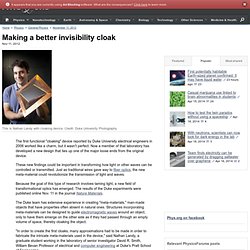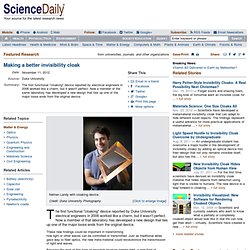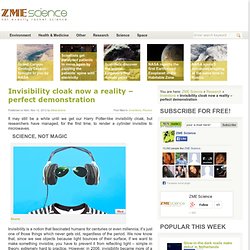Zoom
Trash

'Perfect' INVISIBLE SHED stuns boffinry world. High performance access to file storage Invisibility cloaks - or, more correctly, sheds - inched a little closer to reality this week with the revelation that scientists have made an object flawlessly invisible.

Previous attempts to make objects invisible had succeeded in bending light around their edges, but left a dark shadow behind the object because of some light reflecting off it. This time, there was no reflection, no shadow and the object was perfectly invisible. 'Perfect' Invisibility Cloak Is World's First, Scientists Say. A 'perfect' cloak of invisibility has been demonstrated for the first time. (But no, it's not quite Predator-style stuff yet.) Researchers have been able to render a centimetre 7.5 cm in diameter and 1cm tall invisible to microwaves. The trick was made possible by creating a diamond-shaped region in which light was perfectly diverted around the object.
The illusion only works from one direction, however - and the team behind the Nature Materials study say it would be very difficult to reproduce with visible light. Still, it represents the first time that the theory of "transformation optics" developed by John Pendry of Imperial College London and David Schurig and David Smith of Duke University in 2006 has been shown to work without approximations. Usually, attempts to show this effect in action result in imperfections around the edges which show up the object being made invisible. But in this experiment, there were no reflections. Making a better invisibility cloak. The first functional "cloaking" device reported by Duke University electrical engineers in 2006 worked like a charm, but it wasn't perfect.

David R. Smith Group. David R. Smith Group. The paths of light and other electromagnetic waves can be controlled by materials.

The lenses in eye glasses or microscopes, for example, are nothing more than pieces of glass or plastic whose surfaces have been shaped in a particular way so as to achieve a desired optical function. Materials are used to form optical devices that operate across the electromagnetic spectrum, from radio waves to visible light. Nature has provided us a rich palette of material properties from which to engineer useful optical devices. Yet, that palette is limited: Chemical synthesis, the conventional approach to material development, has so far not enabled us to access the entire range of material properties that should be theoretically possible.
But chemistry is not the only process by which we can create materials. At Duke, our group is involved in all aspects of metamaterials research, from fundamental theory to experimental realizations, at wavelengths from RF to visible. Invisibility cloaking in 'perfect' demonstration. 12 November 2012Last updated at 00:50 GMT By Jason Palmer Science and technology reporter, BBC News The trick included developing a diamond-shaped cloaking region - invisible only from one direction Scientists have succeeded in "cloaking" an object perfectly for the first time, rendering a centimetre-scale cylinder invisible to microwaves.

Many "invisibility cloak" efforts have been demonstrated, but all have reflected some of the incident light, making the illusion incomplete. A Nature Materials study has now shown how to pull off the trick flawlessly. However, the illusion only works from one direction and would be difficult to achieve with visible light. Invisibility cloaks: Will we ever really have them? You've seen the films, you've read the popular science stories.

It's time to ask: when will you have your invisibility cloak? Hold your horses. It's looking like a great many things inspired by cloaking science will come to pass before then. Behind most cloaking ideas is the use of metamaterials - materials whose properties are purposefully designed, defined not by chemistry but by the materials' size, shape and structure. How to make things invisible. Metamaterial cloaking. Metamaterial cloaking is the usage of metamaterials in an invisibility cloak.

This is accomplished by manipulating the paths traversed by light through a novel optical material. Metamaterials direct and control the propagation and transmission of specified parts of the light spectrum and demonstrate the potential to render an object seemingly invisible. Metamaterial cloaking, based on transformation optics, describes the process of shielding something from view by controlling electromagnetic radiation.
Objects in the defined location are still present, but incident waves are guided around them without being affected by the object itself.[1][2][3][4][5] [edit] Electromagnetic metamaterials respond to chosen parts of radiated light, also known as the electromagnetic spectrum, in a manner that is difficult or impossible to achieve with natural materials. The artificial structure for cloaking applications is a lattice design – a sequentially repeating network – of identical elements. Making a better invisibility cloak. The first functional "cloaking" device reported by Duke University electrical engineers in 2006 worked like a charm, but it wasn't perfect.

Now a member of that laboratory has developed a new design that ties up one of the major loose ends from the original device. These new findings could be important in transforming how light or other waves can be controlled or transmitted. Just as traditional wires gave way to fiber optics, the new meta-material could revolutionize the transmission of light and waves. Because the goal of this type of research involves taming light, a new field of transformational optics has emerged. The results of the Duke experiments were published online Nov. 11 in the journal Nature Materials. The Duke team has extensive experience in creating "meta-materials," human-made objects that have properties often absent in natural ones.
"One issue, which we were fully aware of, was loss of the waves due to reflections at the boundaries of the device," Landy said. Klingon style cloaking device, now a little closer « Mathematical Ramblings. Invisibility cloak now a reality - perfect demonstration. It may still be a while until we get our Harry Potter-like invisibility cloak, but researchers have managed, for the first time, to render a cylinder invisible to microwaves.

Science, not magic Invisibility is a notion that fascinated humans for centuries or even millennia; it’s just one of those things which never gets old, regardless of the period. We now know that, since we see objects because light bounces of their surface, if we want to make something invisible, you have to prevent it from reflecting light – simple in theory, extremely hard to practice.
However, in 2006, invisibility became more of a practical matter, with the suggestion that artificially structured metamaterials could enable a new electromagnetic design paradigm – something which is now called transformation optics. This new research, published in Nature Materials showed how to pull that trick off flawlessly.